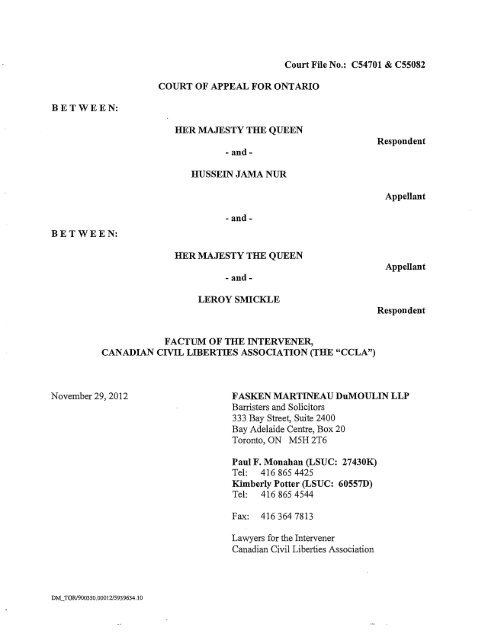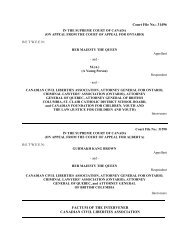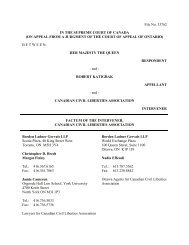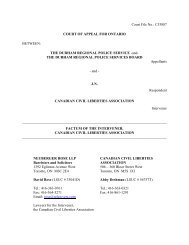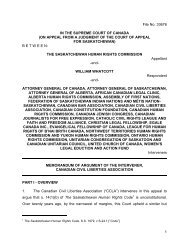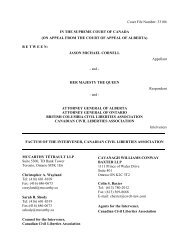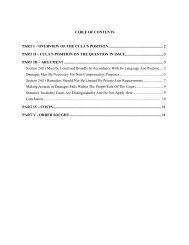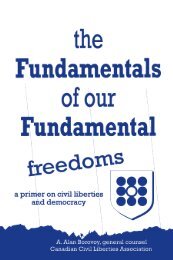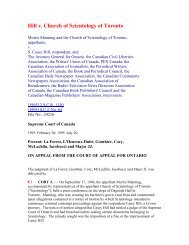Read CCLA's factum at the Court of Appeal - Canadian Civil ...
Read CCLA's factum at the Court of Appeal - Canadian Civil ...
Read CCLA's factum at the Court of Appeal - Canadian Civil ...
Create successful ePaper yourself
Turn your PDF publications into a flip-book with our unique Google optimized e-Paper software.
COURT OF APPEAL FOR ONTARIO<br />
<strong>Court</strong> File No.: C54701 & C55082<br />
BETWEEN:<br />
HER MAJESTY THE QUEEN<br />
- and -<br />
Respondent<br />
HUSSEIN JAMA NUR<br />
Appellant<br />
BETWEEN:<br />
- and -<br />
HER MAJESTY THE QUEEN<br />
- and -<br />
LEROY SMICKLE<br />
Appellant<br />
Respondent<br />
FACTUM OF THE INTERVENER,<br />
CANADIAN CIVIL LIBERTIES ASSOCIATION (THE "CCLA")<br />
November 29, 2012<br />
FASKEN MARTINEAU DuMOULIN LLP<br />
Banisters and Solicitors<br />
333 Bay Street, Suite 2400<br />
Bay Adelaide Centre, Box 20<br />
Toronto, ON M5H 2T6<br />
Paul F. Monahan (LSUC: 27430K)<br />
Tel: 416 865 4425<br />
Kimberly Potter (LSUC: 60557D)<br />
Tel: 416 865 4544<br />
Fax: 416 364 7813<br />
Lawyers for <strong>the</strong> Intervener<br />
<strong>Canadian</strong> <strong>Civil</strong> Liberties Associ<strong>at</strong>ion<br />
DM TOR/900350.00012/5939634.10
TO:<br />
DERSTINE PENMAN<br />
559 College Street<br />
Suite 302<br />
Toronto, Ontario<br />
M6G 1A9<br />
Dirk Derstine<br />
Mariya Yakusheva<br />
Tel: 416 304 1414<br />
Fax: 416 304 1345<br />
Lawyers for Hussein Nur<br />
AND TO: RUSONIK, O'CONNOR, ROBBINS, ROSS, GORHAM & ANGELINI, LLP<br />
36 Lombard Street<br />
Suite 100<br />
Toronto, Ontario<br />
M5C 2X3<br />
Mark C. Halfyard<br />
Jeff Hershb erg<br />
Tel: 416 598 1811<br />
Fax: 416 598 3384<br />
Lawyers for Leroy Smickle<br />
AND TO: ONTARIO COURT OF APPEAL<br />
Clerk's Office<br />
Osgoode Hall<br />
130 Queen Street West<br />
Toronto, Ontario<br />
M5H 2N5<br />
AND TO: CROWN ATTORNEY'S OFFICE<br />
Crown Law Office Criminal<br />
720 Bay Street, 10 th Floor<br />
Toronto, Ontario<br />
M7A 2N5<br />
Riun Shandler<br />
Andrea Baiasu<br />
Tel: 416 326 2353<br />
Fax: 416 326 4656<br />
Lawyers for <strong>the</strong> Attorney General for Ontario<br />
DM_TOR/900350.00012/5939634.10
2<br />
AND TO: DEPARTMENT OF JUSTICE CANADA<br />
Ontario Regional Office<br />
First <strong>Canadian</strong> Place<br />
130 King Street West<br />
Suite 3400, Box 36<br />
Toronto, Ontario<br />
M5X 1K6<br />
Nancy Dennison<br />
Tel: 416 956 8032<br />
Moiz Rahman<br />
Tel: 416 952 6214<br />
Fax: 416 973 4328<br />
Lawyers for <strong>the</strong> Attorney General <strong>of</strong> Canada<br />
AND TO: AFRICAN CANADIAN LEGAL CLINIC<br />
18 King Street East<br />
Suite 901<br />
Toronto, ON M5C 1C4<br />
Faisal Mirza<br />
Virginia Nelder<br />
Tel: 416-214-4747<br />
Fax: 416-214-4748<br />
Lawyers for <strong>the</strong> African <strong>Canadian</strong> Legal Clinic<br />
BARNES SAMMON LLP<br />
200 Elgin Street,<br />
Suite 400<br />
Ottawa, Ontario<br />
K2P 1L5<br />
Bruce F. Simpson<br />
Tel: 613 594 8000<br />
Fax: 613 235 7578<br />
Lawyer for <strong>the</strong> John Howard Society<br />
DM TOR/900350.00012/5939634.10
<strong>Court</strong> File No.: C54701 & C55082<br />
BETWEEN:<br />
COURT OF APPEAL FOR ONTARIO<br />
HER MAJESTY THE QUEEN<br />
- and -<br />
HUSSEIN JAMA NUR<br />
Respondent<br />
Appellant<br />
- and -<br />
BETWEEN:<br />
HER MAJESTY THE QUEEN<br />
- and -<br />
LEROY SMICKLE<br />
Appellant<br />
Respondent<br />
FACTUM OF THE INTERVENER,<br />
CANADIAN CIVIL LIBERTIES ASSOCIATION (THE "CCLA")<br />
PART I - OVERVIEW<br />
1. Gun violence is a scourge on our society. In R v. Danvers,' this court held th<strong>at</strong><br />
"gun rel<strong>at</strong>ed crimes" must be addressed by our courts in <strong>the</strong> strongest possible terms. In R v.<br />
Brown, 2 this court held th<strong>at</strong> <strong>the</strong> "use <strong>of</strong> guns in public places" cries out for lengthy sentences.<br />
There may well be cases where an <strong>of</strong>fender convicted <strong>of</strong> an <strong>of</strong>fence under s. 95 <strong>of</strong> <strong>the</strong> Criminal<br />
Code would be deserving <strong>of</strong> a lengthy prison term. However, <strong>the</strong> question before this court is<br />
whe<strong>the</strong>r <strong>the</strong>re are reasonable hypo<strong>the</strong>tical cases in which a three-year mand<strong>at</strong>ory minimum<br />
1 (2005), 199 C.C.C. (3d) 490 (Ont CA), [2005] O.J. No. 3532 (CA) <strong>at</strong> para. 78.<br />
2 2009 ONCA 563 <strong>at</strong> para. 33, [2009] O.J. No. 2908 (CA).<br />
DM TOR/900350.00012/5939634.10
2<br />
sentence would be grossly disproportion<strong>at</strong>e. The CCLA submits th<strong>at</strong> <strong>the</strong>re are such reasonable<br />
hypo<strong>the</strong>ticals, which ultim<strong>at</strong>ely render s. 95(2)(a)(i) unconstitutional.<br />
2. A first-time <strong>of</strong>fender can be convicted <strong>of</strong> an <strong>of</strong>fence under s. 95 without<br />
committing a "gun rel<strong>at</strong>ed crime", and, in fact, without "using" a gun <strong>at</strong> all, let alone in a "public<br />
place." The CCLA submits th<strong>at</strong> in such a situ<strong>at</strong>ion (among potentially o<strong>the</strong>rs), <strong>the</strong> three-year<br />
minimum sentence mand<strong>at</strong>ed by s. 95(2)(a)(i) is grossly disproportion<strong>at</strong>e and constitutes cruel<br />
and unusual punishment contrary to s. 12 <strong>of</strong> <strong>the</strong> <strong>Canadian</strong> Charter <strong>of</strong> Rights and Freedoms (<strong>the</strong><br />
"Charter").3 Moreover, <strong>the</strong> law cannot be saved by s. 1 <strong>of</strong> <strong>the</strong> Charter. As such, <strong>the</strong> appropri<strong>at</strong>e<br />
remedy is to strike down s. 95(2)(a)(i) under s. 52 <strong>of</strong> <strong>the</strong> Constitution Act, 1982.<br />
3. , The CCLA submits th<strong>at</strong> Mr. Justice Code erred in R v. Nur in relying on <strong>the</strong><br />
reasonable exercise <strong>of</strong> prosecutorial discretion to find th<strong>at</strong> s. 95(2)(a)(i) does not viol<strong>at</strong>e s. 12 <strong>of</strong><br />
<strong>the</strong> Charter. In Nur, Code J. reviewed a number <strong>of</strong> hypo<strong>the</strong>ticals th<strong>at</strong> he st<strong>at</strong>ed may well give rise<br />
to cruel and unusual punishment if <strong>the</strong> Crown proceeded by indictment. Code J. ultim<strong>at</strong>ely<br />
rejected <strong>the</strong>se reasonable hypo<strong>the</strong>ticals, as he considered th<strong>at</strong> <strong>the</strong> Crown would elect to proceed<br />
summarily in all <strong>of</strong> <strong>the</strong>se cases, and th<strong>at</strong> it was "far-fetched or only marginally imaginable" th<strong>at</strong><br />
<strong>the</strong> Crown would act o<strong>the</strong>rwise. 4<br />
4. However, it was not long before a fact scenario similar to <strong>the</strong> first hypo<strong>the</strong>tical<br />
Code J. considered involving an <strong>of</strong>fender carrying a loaded gun to show <strong>of</strong>f and post pictures<br />
online actually happened, and <strong>the</strong> Crown elected to proceed by indictment. Th<strong>at</strong> case was R v.<br />
Smickle. Madam Justice Molloy held th<strong>at</strong> <strong>the</strong> Crown's election to proceed by indictment was<br />
3 Part I <strong>of</strong> <strong>the</strong> Constitution Act, 1982, being Schedule B to <strong>the</strong> Canada Act 1982 (UK), 1982, c. 11.<br />
4 2011 ONSC 4874 <strong>at</strong> para. 110, [2011] O.J. No. 3878 (Sup Ct J).<br />
DM TOR/900350.00012/5939634.10
3<br />
made reasonably and in good faith. 5 She never<strong>the</strong>less found, we submit correctly, th<strong>at</strong> <strong>the</strong><br />
mand<strong>at</strong>ory minimum would be grossly disproportion<strong>at</strong>e based on <strong>the</strong> facts as she found <strong>the</strong>m.<br />
PART II - FACTS<br />
5. The CCLA takes no position on any <strong>of</strong> <strong>the</strong> contested facts in <strong>the</strong>se appeals; r<strong>at</strong>her,<br />
we submit th<strong>at</strong> s. 95(2)(a)(i) imposes a grossly disproportion<strong>at</strong>e sentence in reasonable<br />
hypo<strong>the</strong>tical cases in viol<strong>at</strong>ion <strong>of</strong> s. 12 <strong>of</strong> <strong>the</strong> Charter, which cannot be justified under s. 1.<br />
PART III - ISSUES AND LAW<br />
The Analytical Framework under s. 12 <strong>of</strong> <strong>the</strong> Charter<br />
6. Section 12 <strong>of</strong> <strong>the</strong> Charter provides, "Everyone has <strong>the</strong> right not to be subjected to<br />
cruel and unusual punishment." The analytical framework for assessing <strong>the</strong> constitutionality <strong>of</strong><br />
mand<strong>at</strong>ory minimum sentences under s. 12 has been well developed by <strong>the</strong> Supreme <strong>Court</strong> in a<br />
number <strong>of</strong> cases, most notably: R v. Smith, 6 R v. Goltz, 7 R v. Morrisey, 8 and R v. Ferguson. 9<br />
McLachlin C.J.C. summarized <strong>the</strong> analytical framework for s. 12 in Ferguson, <strong>at</strong> para. 14, as<br />
follows:<br />
The test for whe<strong>the</strong>r a particular sentence constitutes cruel and unusual<br />
punishment is whe<strong>the</strong>r <strong>the</strong> sentence is grossly disproportion<strong>at</strong>e: R. v. Smith,<br />
[1987] 1 S.C.R. 1045. As this <strong>Court</strong> has repe<strong>at</strong>edly held, to be considered grossly<br />
disproportion<strong>at</strong>e, <strong>the</strong> sentence must be more than merely excessive. The sentence<br />
must be 'so excessive as to outrage standards <strong>of</strong> decency' and disproportion<strong>at</strong>e to<br />
<strong>the</strong> extent th<strong>at</strong> <strong>Canadian</strong>s 'would find <strong>the</strong> punishment abhorrent or intolerable': R.<br />
v. Wiles, [2005] 3 S.C.R. 895, 2005 SCC 84, <strong>at</strong> para. 4, citing Smith, <strong>at</strong> p. 1072,<br />
and Morrisey, <strong>at</strong> para. 26.<br />
5 2012 ONSC 602 <strong>at</strong> para. 87, 110 O.R. (3d) 25 (Sup Ct J).<br />
6 [1987] 1 S.C.R. 1045.<br />
7 [1991] 3 S.C.R. 485.<br />
s 2000 SCC 39, [2000] 2 S.C.R. 90.<br />
9 2008 SCC 6, [2008] 1 S.C.R. 96.<br />
DM TOR/900350.00012/5939634.10
4<br />
7. The s. 12 analysis proceeds in two stages. First, <strong>the</strong> court must consider whe<strong>the</strong>r<br />
<strong>the</strong> provision constitutes cruel and unusual punishment for <strong>the</strong> particular <strong>of</strong>fence and <strong>of</strong>fender<br />
being sentenced. Second, if <strong>the</strong> particular facts <strong>of</strong> <strong>the</strong> case do not result in gross<br />
disproportionality, <strong>the</strong>n <strong>the</strong> court must consider whe<strong>the</strong>r <strong>the</strong> sentence would amount to cruel and<br />
unusual punishment in reasonable hypo<strong>the</strong>tical circumstances. I° The <strong>CCLA's</strong> submissions focus<br />
solely on <strong>the</strong> second stage <strong>of</strong> this analysis.<br />
8. The reasonable hypo<strong>the</strong>tical analysis has become more important since Ferguson,<br />
where <strong>the</strong> court held th<strong>at</strong> a constitutional exemption is not available for a "small <strong>of</strong>fender" 11<br />
subject to a mand<strong>at</strong>ory minimum sentence. 12 If a mand<strong>at</strong>ory minimum would result in a grossly<br />
disproportion<strong>at</strong>e sentence for a small <strong>of</strong>fender, <strong>the</strong> court held th<strong>at</strong> <strong>the</strong> appropri<strong>at</strong>e remedy is to<br />
strike down <strong>the</strong> law pursuant to s. 52 <strong>of</strong> <strong>the</strong> Constitution Act, 1982.<br />
The Hypo<strong>the</strong>tical Scenarios Relied on by Code J. in Nur are "Reasonable Hypo<strong>the</strong>ticals"<br />
9. The CCLA submits th<strong>at</strong> <strong>the</strong> hypo<strong>the</strong>tical scenarios relied on by Code J. constitute<br />
"reasonable hypo<strong>the</strong>ticals." These hypo<strong>the</strong>ticals are set out in Code J.'s judgment in Nur 13 and<br />
may be briefly summarized as follows:<br />
• A teenager shows <strong>of</strong>f his f<strong>at</strong>her's firearm <strong>at</strong> a party and a picture is posted online;<br />
• A family member transports a firearm to <strong>the</strong> licensee;<br />
• A person purchases a ranch which contents include a firearm th<strong>at</strong> <strong>the</strong> purchaser<br />
never registers; 14<br />
1° Goltz, supra note 7 <strong>at</strong> pp. 506-506.<br />
II The term "small <strong>of</strong>fender" comes from Smith, supra note 6 <strong>at</strong> p. 1078.<br />
12 Ferguson, supra note 9 <strong>at</strong> para. 74.<br />
13<br />
Nur, supra note 4 <strong>at</strong> para. 96.<br />
14 These facts arose in R v. Snobelen, (25 April 2008), Toronto, S.D. Brown J. (Ont Ct J) [unreported].<br />
DM TOR/900350.00012/5939634.10
5<br />
• An American tourist brings a firearm to Canada th<strong>at</strong> is licensed in <strong>the</strong> US but not<br />
in Canada; and<br />
• A firearms collection is inherited by family members who never register <strong>the</strong><br />
firearms.<br />
10. Reasonable hypo<strong>the</strong>ticals must not be "far-fetched or marginally imaginable<br />
cases." 15 In constructing hypo<strong>the</strong>tical cases, Gonthier J. for <strong>the</strong> majority in Morrisey held th<strong>at</strong><br />
"reported cases can be used with caution as a starting point, and additional circumstances can be<br />
added to <strong>the</strong> scenario to construct an appropri<strong>at</strong>e model against which to test <strong>the</strong> severity <strong>of</strong> <strong>the</strong><br />
punishment." 16 He held th<strong>at</strong> "<strong>the</strong> proper approach is to develop imaginable circumstances which<br />
could commonly arise with a degree <strong>of</strong> generality appropri<strong>at</strong>e to <strong>the</strong> particular <strong>of</strong>fence." 17<br />
11. The CCLA disagrees with <strong>the</strong> argument put forward by <strong>the</strong> Attorney Generals for<br />
Ontario and Canada th<strong>at</strong> <strong>the</strong> hypo<strong>the</strong>tical scenarios relied on by Code J. represent marginal cases<br />
<strong>of</strong> technical licensing viol<strong>at</strong>ions to which <strong>the</strong> mand<strong>at</strong>ory minimum sentence would not apply. 18<br />
The Attorney General for Ontario sets out two defences supposedly available to an accused<br />
charged with a s. 95 <strong>of</strong>fence: mistake <strong>of</strong> fact in rel<strong>at</strong>ion to <strong>the</strong> existence and terms <strong>of</strong> a license for<br />
possession, and absence <strong>of</strong> blameworthy st<strong>at</strong>e <strong>of</strong> mind despite de facto possession. 19 The CCLA<br />
submits th<strong>at</strong> <strong>the</strong>se defences are very narrow in applic<strong>at</strong>ion and could not reasonably be raised in<br />
any <strong>of</strong> <strong>the</strong> hypo<strong>the</strong>tical scenarios considered in Nur.<br />
12. The mistake <strong>of</strong> fact defence was relied on in R v. MacDonald. 2° In th<strong>at</strong> case, <strong>the</strong><br />
accused was charged with a s. 95 <strong>of</strong>fence after <strong>the</strong> police entered his Halifax apartment in<br />
response to a noise complaint and observed him carrying a loaded firearm. The case turned on a<br />
15 Goltz, supra note 7 <strong>at</strong> p. 506.<br />
16 Morrisey, supra note 8 <strong>at</strong> para. 33.<br />
17 Ibid. <strong>at</strong> para. 50.<br />
18 Factum <strong>of</strong> <strong>the</strong> Attorney General for Ontario <strong>at</strong> para. 96; Factum <strong>of</strong> <strong>the</strong> Attorney General for Canada <strong>at</strong> para. 58.<br />
19 Factum <strong>of</strong> <strong>the</strong> Attorney General for Ontario, ibid.<br />
20 2012 NSCA 50, [2012] N.S.J. No. 252 (CA), leave to appeal to SCC granted.<br />
DM_TOR/900350.00012/5939634.10
6<br />
technical interpret<strong>at</strong>ion <strong>of</strong> s. 17 <strong>of</strong> <strong>the</strong> Firearms Act21 ; specifically, whe<strong>the</strong>r this provision only<br />
authorizes possession <strong>of</strong> a firearm <strong>at</strong> a dwelling-house th<strong>at</strong> is recorded in <strong>the</strong> <strong>Canadian</strong> Firearms<br />
Registry, or whe<strong>the</strong>r possession is authorized <strong>at</strong> any dwelling-house. The defence argued th<strong>at</strong> <strong>the</strong><br />
accused was authorized to possess <strong>the</strong> firearm in his apartment in Halifax and not only <strong>at</strong> his<br />
home in Calgary where <strong>the</strong> firearm was registered.<br />
13. After a thorough exercise in st<strong>at</strong>utory interpret<strong>at</strong>ion, <strong>the</strong> Nova Scotia <strong>Court</strong> <strong>of</strong><br />
<strong>Appeal</strong> held th<strong>at</strong> <strong>the</strong> accused was not authorized to possess <strong>the</strong> firearm in Halifax, but agreed<br />
with <strong>the</strong> defence th<strong>at</strong> <strong>the</strong> accused should not be convicted <strong>of</strong> <strong>the</strong> <strong>of</strong>fence because he honestly<br />
believed th<strong>at</strong> his possession was authorized. The court was careful to limit <strong>the</strong> scope <strong>of</strong> this<br />
defence, however. First, <strong>the</strong> court distinguished between a mistake <strong>of</strong> law and a mistake <strong>of</strong> fact.<br />
The accused did not assert th<strong>at</strong> he was unaware th<strong>at</strong> he required authoriz<strong>at</strong>ion to possess <strong>the</strong><br />
firearm, a mistake <strong>of</strong> law; r<strong>at</strong>her, he erroneously believed th<strong>at</strong> he was so authorized, a mistake <strong>of</strong><br />
fact. 22 Second, <strong>the</strong> court held th<strong>at</strong> an accused's belief th<strong>at</strong> he is authorized to possess a firearm<br />
must be honestly held. 23 Finally, <strong>the</strong> court held th<strong>at</strong> an accused must not be willfully blind with<br />
respect to whe<strong>the</strong>r he is authorized to possess <strong>the</strong> firearm. 24<br />
14. The CCLA submits th<strong>at</strong> none <strong>of</strong> <strong>the</strong> reasonable hypo<strong>the</strong>ticals raised in Nur give<br />
rise to a legitim<strong>at</strong>e defence <strong>of</strong> mistake <strong>of</strong> fact. The court in MacDonald was clear th<strong>at</strong> it was not<br />
in any way detracting from <strong>the</strong> well-known principle enshrined in s. 19 <strong>of</strong> <strong>the</strong> Criminal Code th<strong>at</strong><br />
ignorance <strong>of</strong> <strong>the</strong> law is not an excuse for committing an <strong>of</strong>fence. 25<br />
21 S.C. 1995, c. 39.<br />
22 MacDonald, supra note 20 <strong>at</strong> para. 69.<br />
23 Ibid. <strong>at</strong> para. 87.<br />
24 Ibid. <strong>at</strong> para. 89.<br />
25 Ibid. <strong>at</strong> paras. 68-69.<br />
DM_TOR/900350.00012/5939634.10
7<br />
15. Similarly, <strong>the</strong> second defence posited by <strong>the</strong> Attorney General for Ontario, <strong>the</strong><br />
defence th<strong>at</strong> <strong>the</strong>re was no accompanying blameworthy intent, is very limited in scope. This<br />
defence was described by Doherty J.A. in R v. Chalk 26 as follows:<br />
There are cases where an individual has <strong>the</strong> requisite control and knowledge, but<br />
cannot be said to be in possession for <strong>the</strong> purpose <strong>of</strong> imposing criminal liability.<br />
These cases will include cases in which a person takes control <strong>of</strong> contraband<br />
exclusively for <strong>the</strong> purpose <strong>of</strong> immedi<strong>at</strong>ely destroying <strong>the</strong> contraband or<br />
o<strong>the</strong>rwise placing it permanently beyond th<strong>at</strong> person's ability to exercise any<br />
control over <strong>the</strong> contraband. In such cases, <strong>the</strong> intention is solely to divest oneself<br />
<strong>of</strong> control r<strong>at</strong>her than to possess. 27 [Emphasis added].<br />
None <strong>of</strong> <strong>the</strong> reasonable hypo<strong>the</strong>tical cases give rise to such a defence.<br />
16. Contrary to <strong>the</strong> assertion <strong>of</strong> <strong>the</strong> Attorney Generals <strong>of</strong> Ontario and Canada, <strong>the</strong><br />
scenarios referenced by Code J. in Nur are not mere technical viol<strong>at</strong>ions for which an accused<br />
could reasonably rely on <strong>the</strong> defence <strong>of</strong> mistake <strong>of</strong> fact or lack <strong>of</strong> blameworthy intent. The<br />
CCLA submits th<strong>at</strong> <strong>the</strong>se are reasonable hypo<strong>the</strong>ticals th<strong>at</strong> could give rise to a conviction under<br />
s. 95 <strong>of</strong> <strong>the</strong> Criminal Code, and so <strong>the</strong> three-year mand<strong>at</strong>ory minimum sentence would apply.<br />
O<strong>the</strong>r Reasonable Hypo<strong>the</strong>tical Scenarios<br />
17. In addition to <strong>the</strong> reasonable hypo<strong>the</strong>tical cases canvassed by Code J., <strong>the</strong> CCLA<br />
submits th<strong>at</strong> <strong>the</strong>re are many o<strong>the</strong>r reasonable hypo<strong>the</strong>tical cases which could give rise to a<br />
conviction under s. 95 in a context where <strong>the</strong> three year sentence would be grossly<br />
disproportion<strong>at</strong>e. These cases share <strong>the</strong> following general fe<strong>at</strong>ures:<br />
• The accused does not have a prior criminal record or has a criminal record th<strong>at</strong> is<br />
insignificant;<br />
• The accused did not possess <strong>the</strong> firearm in a public place (i.e. <strong>the</strong> accused was in a<br />
car or <strong>at</strong> home); and<br />
• The accused did not possess <strong>the</strong> firearm for any criminal purpose.<br />
26 2007 ONCA 815, 88 O.R. (3d) 448 (CA).<br />
27 Ibid. <strong>at</strong> para. 25.<br />
DM_TOR/900350.00012/5939634.10
8<br />
18. There are a number <strong>of</strong> reported cases th<strong>at</strong> share <strong>the</strong>se characteristics. As will be<br />
set out in gre<strong>at</strong>er detail below, <strong>the</strong>se hypo<strong>the</strong>ticals would take on even more significance if any<br />
<strong>of</strong> <strong>the</strong> <strong>of</strong>fenders in <strong>the</strong>se cases were Aboriginal.<br />
• In R v. Bergaur-Free,28 <strong>the</strong> accused was found guilty <strong>of</strong> a single count <strong>of</strong><br />
possession <strong>of</strong> a prohibited firearm with readily accessible ammunition contrary to<br />
s. 95(1) <strong>of</strong> <strong>the</strong> Criminal Code. A police <strong>of</strong>ficer pulled over <strong>the</strong> accused's vehicle<br />
and searched his trunk. The <strong>of</strong>ficer found a locked metal box with a firearm and<br />
ammunition inside. The accused, a trooper in <strong>the</strong> <strong>Canadian</strong> militia, was 21 years<br />
old, had no criminal record, and a very positive pre-sentence report. The Crown<br />
proceeded by indictment and <strong>the</strong> accused was sentenced to <strong>the</strong> mand<strong>at</strong>ory<br />
minimum sentence, which <strong>at</strong> th<strong>at</strong> time was one year.<br />
• In R v. A1i, 29 <strong>the</strong> accused was convicted <strong>of</strong> possession <strong>of</strong> a loaded prohibited<br />
firearm. The police conducted surveillance following an anonymous call from<br />
someone claiming to have seen <strong>the</strong> accused place wh<strong>at</strong> looked like a rifle in a car<br />
parked outside <strong>of</strong> a house. After <strong>the</strong> accused drove away in <strong>the</strong> car, <strong>the</strong> accused<br />
was apprehended, and <strong>the</strong> police found a loaded, sawed-<strong>of</strong>f, 12-gauge shotgun<br />
bene<strong>at</strong>h <strong>the</strong> driver's se<strong>at</strong>. The defence conceded th<strong>at</strong> <strong>the</strong> accused had possession<br />
<strong>of</strong> <strong>the</strong> firearm, but <strong>the</strong> accused testified th<strong>at</strong> he did not know th<strong>at</strong> <strong>the</strong> firearm was<br />
in <strong>the</strong> car. The court held th<strong>at</strong> <strong>the</strong> Crown proved beyond a reasonable doubt th<strong>at</strong><br />
<strong>the</strong> accused knew about <strong>the</strong> firearm and sentenced him to 14 months<br />
imprisonment. The court noted th<strong>at</strong> <strong>the</strong> accused had a very supportive family, no<br />
criminal record, and had led an o<strong>the</strong>rwise unblemished life.<br />
• In R v. Canepa,3° a case cited by Molloy J., police <strong>of</strong>ficers <strong>at</strong>tended <strong>at</strong> <strong>the</strong><br />
accused's apartment in response to a call about <strong>the</strong> smell <strong>of</strong> marijuana eman<strong>at</strong>ing<br />
from <strong>the</strong> apartment. The police were granted entry, and once inside <strong>the</strong>y saw a<br />
small quantity <strong>of</strong> marijuana on a table and found a loaded firearm under <strong>the</strong> table.<br />
The accused pled guilty to one count <strong>of</strong> possession <strong>of</strong> an unauthorized firearm.<br />
The accused was 18 years old <strong>at</strong> <strong>the</strong> time <strong>of</strong> <strong>the</strong> <strong>of</strong>fence and had no criminal<br />
record. He was given a conditional sentence.<br />
• In R v. Beaman, 31 <strong>the</strong> accused pled guilty to possessing a prohibited firearm with<br />
readily accessible ammunition and possession <strong>of</strong> marijuana following a police<br />
search <strong>of</strong> his property. The accused had a criminal record, but it didn't include<br />
any jail time in <strong>the</strong> last 20 years. The Crown proceeded summarily. The court<br />
accepted th<strong>at</strong> <strong>the</strong> firearm charge was unrel<strong>at</strong>ed to <strong>the</strong> drug charge, and th<strong>at</strong> <strong>the</strong><br />
firearm, a semi-autom<strong>at</strong>ic pistol, was found incidental to <strong>the</strong> search for <strong>the</strong> drugs.<br />
The court held th<strong>at</strong> <strong>the</strong> appropri<strong>at</strong>e sentence for <strong>the</strong> firearms charge was 3 months.<br />
28 [2008] O.J. No. 2904 (Sup Ct J), rev'd on o<strong>the</strong>r grounds 2009 ONCA 610.<br />
29 2007 CarswellOnt 9671 (Sup Ct J); 2008 CarswellOnt 7764 (Sup Ct J), <strong>of</strong> 'd 2008 ONCA 741.<br />
3° 2011 ONSC 1406, [2011] O.J. No. 924 (Sup Ct J).<br />
31 2010 NBQB 103, 356 N.B.R. (2d) 385 (QB).<br />
DM TOR/900350.00012/5939634.10
9<br />
Although in many <strong>of</strong> <strong>the</strong>se cases <strong>the</strong> Crown elected to proceed summarily, <strong>the</strong> Crown could have<br />
just as easily elected to proceed by indictment, as is set out in more detail below. In o<strong>the</strong>r words,<br />
just like in Smith, <strong>the</strong> "n<strong>at</strong>ural and probable consequence" <strong>of</strong> s. 95 would be to "c<strong>at</strong>ch individuals<br />
who could only be described as 'small <strong>of</strong>fenders'". 32<br />
The Mand<strong>at</strong>ory Minimum Sentence is Grossly Disproportion<strong>at</strong>e in Reasonable<br />
Hypo<strong>the</strong>tical Cases and on <strong>the</strong> Facts as Found by Molloy J. in Smickle<br />
19. The CCLA submits th<strong>at</strong> Code J. erred in relying on prosecutorial discretion to<br />
find th<strong>at</strong> <strong>the</strong> reasonable hypo<strong>the</strong>tical cases would not give rise to a s. 12 viol<strong>at</strong>ion, a point<br />
apparently conceded by <strong>the</strong> Attorney Generals for Ontario and Canada. 33 However, <strong>the</strong> CCLA<br />
submits th<strong>at</strong> Code J. was correct in implying in obiter th<strong>at</strong> <strong>the</strong> mand<strong>at</strong>ory minimum sentence<br />
would be grossly disproportion<strong>at</strong>e if <strong>the</strong> Crown proceeded by indictment in <strong>the</strong>se cases. 34<br />
20. The CCLA submits th<strong>at</strong> <strong>the</strong> facts as found by Molloy J. also result in a situ<strong>at</strong>ion in<br />
which <strong>the</strong> three-year mand<strong>at</strong>ory minimum would be a grossly disproportion<strong>at</strong>e sentence. Molloy<br />
J. found th<strong>at</strong> Mr. Smickle was alone in his cousin's apartment taking pictures for his Facebook<br />
page with a loaded handgun in one hand when <strong>the</strong> police entered <strong>the</strong> apartment. Mr. Smickle had<br />
no prior criminal record and a positive pre-sentence report. Molloy J. held th<strong>at</strong> a one-year<br />
sentence was appropri<strong>at</strong>e for Mr. Smickle's "single act <strong>of</strong> bad judgment and foolishness." 35<br />
32 Morrisey, supra note 8 <strong>at</strong> para. 30.<br />
33 Factum <strong>of</strong> <strong>the</strong> Attorney General for Ontario <strong>at</strong> paras. 106-108; Factum <strong>of</strong> <strong>the</strong> Attorney General for Canada <strong>at</strong><br />
paras. 61-66.<br />
34 Code J. held, <strong>at</strong> para: 117: "If <strong>the</strong> Crown elects to proceed by indictment in a s. 95 case, based on incomplete<br />
knowledge <strong>of</strong> <strong>the</strong> facts, and a very different case l<strong>at</strong>er emerges <strong>at</strong> trial, a s. 12 Charter motion may well succeed<br />
<strong>at</strong> <strong>the</strong> sentencing stage <strong>of</strong> proceedings." He fur<strong>the</strong>r held, <strong>at</strong> para. 118, "The first improvident Crown election, to<br />
proceed by indictment when <strong>the</strong> proper election was to proceed summarily, may well result in a successful s. 12<br />
Charter motion."<br />
35 Smickle, supra, note 5 <strong>at</strong> para. 81.<br />
DM TOR/900350.00012/5939634.10
- 10 -<br />
Code J. erred in relying on <strong>the</strong> reasonable exercise <strong>of</strong> prosecutorial discretion to find th<strong>at</strong> s.<br />
95(2)(a)(1) does not viol<strong>at</strong>e s. 12 <strong>of</strong> <strong>the</strong> Charter<br />
21. Code J. erred in holding th<strong>at</strong> <strong>the</strong> hypo<strong>the</strong>tical cases he considered would not give<br />
rise to a s. 12 viol<strong>at</strong>ion because <strong>the</strong>y are all cases in which <strong>the</strong> Crown would reasonably elect to<br />
proceed summarily. In Smith, Lamer J. held th<strong>at</strong> courts cannot rely on <strong>the</strong> proper use <strong>of</strong><br />
prosecutorial discretion to save a law th<strong>at</strong> would o<strong>the</strong>rwise run afoul <strong>of</strong> s. 12 <strong>of</strong> <strong>the</strong> Charter:<br />
In my view <strong>the</strong> section cannot be salvaged by relying on <strong>the</strong> discretion <strong>of</strong> <strong>the</strong><br />
prosecution not to apply <strong>the</strong> law in those cases where, in <strong>the</strong> opinion <strong>of</strong><br />
<strong>the</strong> prosecution, its applic<strong>at</strong>ion would be a viol<strong>at</strong>ion <strong>of</strong> <strong>the</strong> Charter. To do so<br />
would be to disregard totally s. 52 <strong>of</strong> <strong>the</strong> Constitution Act, 1982 which provides<br />
th<strong>at</strong> any law which is inconsistent with <strong>the</strong> Constitution is <strong>of</strong> no force or<br />
effect to <strong>the</strong> extent <strong>of</strong> <strong>the</strong> inconsistency and <strong>the</strong> courts are duty bound to<br />
make th<strong>at</strong> pronouncement, not to deleg<strong>at</strong>e <strong>the</strong> avoidance <strong>of</strong> a viol<strong>at</strong>ion to <strong>the</strong><br />
prosecution or to anyone else for th<strong>at</strong> m<strong>at</strong>ter. 36 [Emphasis added].<br />
22. The CCLA submits th<strong>at</strong> Code J. erred in distinguishing <strong>the</strong> prosecutorial<br />
discretion <strong>at</strong> issue in Smith, i.e. <strong>the</strong> discretion "not to apply <strong>the</strong> law" (in o<strong>the</strong>r words, charge an<br />
accused with a lesser <strong>of</strong>fence), from <strong>the</strong> prosecutorial discretion <strong>at</strong> issue in Nur, i.e. <strong>the</strong><br />
discretion to proceed summarily or by indictment. He erroneously held th<strong>at</strong> <strong>the</strong> former type <strong>of</strong><br />
prosecutorial discretion is "an extraordinary discretion" th<strong>at</strong> is not comparable with <strong>the</strong> l<strong>at</strong>ter. 37<br />
23. In fact, both types <strong>of</strong> discretion fall within <strong>the</strong> "core elements" <strong>of</strong> prosecutorial<br />
discretion. In Kreiger v. Law Society <strong>of</strong> Alberta, 38 <strong>the</strong> Supreme <strong>Court</strong> described <strong>the</strong>se core<br />
elements as involving "<strong>the</strong> ultim<strong>at</strong>e decisions as to whe<strong>the</strong>r a prosecution should be brought,<br />
continued or ceased, and wh<strong>at</strong> <strong>the</strong> prosecution ought to be for. Put differently, prosecutorial<br />
discretion refers to decisions regarding <strong>the</strong> n<strong>at</strong>ure and extent <strong>of</strong> <strong>the</strong> prosecution and <strong>the</strong> Attorney<br />
36 Smith, supra note 6 <strong>at</strong> p. 1078.<br />
37 Nur, supra note 4 <strong>at</strong> para. 109.<br />
38 2002 SCC 65, [2002] 3 S.C.R. 372.<br />
DM TOR/900350.00012/5939634.10
General's particip<strong>at</strong>ion in it" 39 (emphasis in original). The CCLA submits th<strong>at</strong> <strong>the</strong>re is no<br />
principled distinction between <strong>the</strong> acts <strong>of</strong> discretion <strong>at</strong> issue in Smith and Nur; <strong>the</strong>refore, Code J.<br />
was bound by <strong>the</strong> holding in Smith th<strong>at</strong> prosecutorial discretion is no answer to a s. 12 viol<strong>at</strong>ion.<br />
Indeed, Molloy J. rejected any distinction between <strong>the</strong> two types <strong>of</strong> discretion in her s. 1 analysis<br />
in Smickle . 4°<br />
24. In any event, it is inappropri<strong>at</strong>e to rely on <strong>the</strong> reasonable exercise <strong>of</strong> prosecutorial<br />
discretion to save a law th<strong>at</strong> would o<strong>the</strong>rwise be found unconstitutional. The Crown may make a<br />
particular election for any number <strong>of</strong> reasons. As Code J. himself observed, Crown elections to<br />
proceed summarily or by an indictment are usually made <strong>at</strong> an early stage <strong>of</strong> proceedings when<br />
<strong>the</strong> Crown is not necessarily in possession <strong>of</strong> all <strong>the</strong> facts. 41 This is exactly wh<strong>at</strong> happened in<br />
Smickle. Moreover, as <strong>the</strong> Supreme <strong>Court</strong> recognized in R v. T (l.), 42 not all cases will be dealt<br />
with in <strong>the</strong> same way. 43 As a result, <strong>the</strong> Crown could reasonably have elected to proceed by<br />
indictment in any <strong>of</strong> <strong>the</strong> above hypo<strong>the</strong>tical cases with <strong>the</strong> result th<strong>at</strong> <strong>the</strong> three-year mand<strong>at</strong>ory<br />
minimum sentence would <strong>at</strong>tach. This is especially so given th<strong>at</strong> <strong>the</strong> Crown Policy Manual<br />
places significant constraints on <strong>the</strong> Crown's ability to proceed summarily in s. 95 cases. 44<br />
39 Ibid <strong>at</strong> para. 47.<br />
Smickle, supra note 5 <strong>at</strong> para. 110.<br />
41 Nur, supra note 4 <strong>at</strong> para. 117.<br />
42 [1992] 1 S.C.R. 749.<br />
43 The court in R. v. T.. (V.) <strong>at</strong> p. 760 cited R v. Poirer, [1989] M.J. No. 279 (Man. Prov. Ct.), with approval, in which<br />
Giesbrecht J. observed, <strong>at</strong> p. 11-12: "In <strong>the</strong> criminal law process prosecutorial discretion exists throughout <strong>the</strong><br />
entire process . . . The people involved in <strong>the</strong> process . . . are not <strong>the</strong> same nor will <strong>the</strong>y necessarily act in <strong>the</strong><br />
same way in exercising <strong>the</strong> discretion <strong>the</strong>y have. This may lead to a situ<strong>at</strong>ion where one person is charged with<br />
an <strong>of</strong>fence, while ano<strong>the</strong>r in seemingly identical circumstances is not; one person is prosecuted by indictment<br />
ano<strong>the</strong>r by summary conviction; one person is dealt with under one provision <strong>of</strong> a particular st<strong>at</strong>ute while ano<strong>the</strong>r<br />
is dealt with under a different, perhaps harsher provision." [Emphasis added].<br />
44 Nur, supra note 4 <strong>at</strong> para. 118; Code J. also erred in asserting, <strong>at</strong> para. 117, th<strong>at</strong> "one unwise Crown election may<br />
end up invalid<strong>at</strong>ing Parliament's s. 95 sentencing scheme for all cases." If <strong>the</strong> constitutional validity <strong>of</strong> s.<br />
95(2)(a)(i) depends solely on <strong>the</strong> Crown's ill-advised decision to proceed by indictment in a particular case, <strong>the</strong><br />
appropri<strong>at</strong>e remedy would be granted under s. 24(1) <strong>of</strong> <strong>the</strong> Charter, which provides a remedy for<br />
unconstitutional government acts. The law would not be struck down under s. 52 <strong>of</strong> <strong>the</strong> Constitution Act, 1982,<br />
because <strong>the</strong> law itself is not <strong>the</strong> source <strong>of</strong> <strong>the</strong> Charter infringement (see Ferguson, supra note 9 <strong>at</strong> paras. 59-61).<br />
DM_TOR/900350.00012/5939634.10
- 12 -<br />
25. Fur<strong>the</strong>rmore, reliance on <strong>the</strong> Crown's discretion to save a law from imposing a<br />
grossly disproportion<strong>at</strong>e sentence is inappropri<strong>at</strong>e in light <strong>of</strong> <strong>the</strong> open court principle and <strong>the</strong><br />
general value <strong>of</strong> transparency in <strong>the</strong> legal system. Upholding a law th<strong>at</strong> has <strong>the</strong> potential to be<br />
applied in such a way as to viol<strong>at</strong>e <strong>the</strong> Charter undermines our commitment to <strong>the</strong> rule <strong>of</strong> law.<br />
The Mand<strong>at</strong>ory Minimum is Grossly Disproportion<strong>at</strong>e in Reasonable Hypo<strong>the</strong>tical Cases<br />
26. The CCLA submits th<strong>at</strong> <strong>the</strong> mand<strong>at</strong>ory minimum sentence would be grossly<br />
disproportion<strong>at</strong>e in <strong>the</strong> above hypo<strong>the</strong>tical cases. The Supreme <strong>Court</strong> in Smith identified <strong>the</strong><br />
following factors to consider in assessing whe<strong>the</strong>r a sentence is grossly disproportion<strong>at</strong>e: <strong>the</strong><br />
gravity <strong>of</strong> <strong>the</strong> <strong>of</strong>fence; <strong>the</strong> personal characteristics <strong>of</strong> <strong>the</strong> <strong>of</strong>fender; <strong>the</strong> particular circumstances<br />
<strong>of</strong> <strong>the</strong> case; and <strong>the</strong> actual effect <strong>of</strong> <strong>the</strong> punishment on <strong>the</strong> <strong>of</strong>fender. 45 O<strong>the</strong>r factors to consider<br />
include: whe<strong>the</strong>r <strong>the</strong> punishment is necessary to achieve a valid penal purpose; whe<strong>the</strong>r it is<br />
founded on recognized sentencing principles; whe<strong>the</strong>r valid altern<strong>at</strong>ives to <strong>the</strong> punishment<br />
imposed exist; and, to some extent, whe<strong>the</strong>r a comparison with punishments imposed for o<strong>the</strong>r<br />
crimes in <strong>the</strong> same jurisdiction reveals gre<strong>at</strong> disproportion. 46 The court must consider not only<br />
<strong>the</strong> dur<strong>at</strong>ion <strong>of</strong> <strong>the</strong> sentence, but its n<strong>at</strong>ure and <strong>the</strong> conditions under which it is applied. 47<br />
27. With respect to <strong>the</strong> first factor, <strong>the</strong> Supreme <strong>Court</strong> has held th<strong>at</strong> <strong>the</strong> gravity <strong>of</strong> <strong>the</strong><br />
<strong>of</strong>fence is a function <strong>of</strong> both <strong>the</strong> character <strong>of</strong> <strong>the</strong> <strong>of</strong>fender's actions and <strong>the</strong> consequences <strong>of</strong><br />
those actions. 48 In considering <strong>the</strong> character <strong>of</strong> <strong>the</strong> <strong>of</strong>fender's actions, <strong>the</strong> court looks to <strong>the</strong> mens<br />
rea <strong>of</strong> <strong>the</strong> <strong>of</strong>fence. 49 Section 95 requires <strong>the</strong> Crown to prove th<strong>at</strong> an accused knowingly<br />
45 Smith, supra note 6 <strong>at</strong> p. 1073.<br />
46 Ibid <strong>at</strong> p. 1074; Goltz, supra note 7 <strong>at</strong> p. 500.<br />
47 Smith, ibid. p. 1073.<br />
48 Morrisey, supra note 8 <strong>at</strong> para. 35; R v. L<strong>at</strong>imer, 2001 SCC 1, [2001] 1 S.C.R. 3 <strong>at</strong> para. 80<br />
49 L<strong>at</strong>imer, ibid. <strong>at</strong> para. 82.<br />
DM_TOR/900350.00012/5939634.10
- 13 -<br />
possessed a prohibited or restricted firearm th<strong>at</strong> is ei<strong>the</strong>r loaded or is accompanied by readily<br />
accessible ammunition. 50 In o<strong>the</strong>r words, <strong>the</strong> mens rea is simply knowledge <strong>of</strong> mere possession.<br />
28. This mens rea requirement is much less morally blameworthy than <strong>the</strong> mens rea<br />
requirement <strong>of</strong> o<strong>the</strong>r firearm <strong>of</strong>fences for which mand<strong>at</strong>ory minimum sentences have been<br />
upheld. For example, criminal negligence causing de<strong>at</strong>h involving a firearm (addressed in<br />
Morrisey) requires conduct which shows a wanton or reckless disregard for <strong>the</strong> life or safety <strong>of</strong><br />
o<strong>the</strong>rs. 51 Manslaughter involving a firearm (addressed in Ferguson) requires objective foresight<br />
<strong>of</strong> <strong>the</strong> risk <strong>of</strong> bodily harm th<strong>at</strong> is more than trivial or transitory. 52 Section 95, by contrast, only<br />
requires th<strong>at</strong> <strong>the</strong> <strong>of</strong>fender knowingly possess a prohibited or restricted firearm th<strong>at</strong> is loaded or is<br />
accompanied by readily accessible ammunition; <strong>the</strong> mens rea does not require th<strong>at</strong> <strong>the</strong> accused<br />
know, or ought to know, th<strong>at</strong> his conduct puts o<strong>the</strong>rs <strong>at</strong> risk. The s. 95 fault requirement is even<br />
less morally blameworthy when <strong>the</strong> firearm is not loaded but is r<strong>at</strong>her accompanied by "readily<br />
accessible ammunition." In R v. Khan, 53 Justice Then for <strong>the</strong> Ontario Superior <strong>Court</strong> interpreted<br />
"readily accessible ammunition" to include a situ<strong>at</strong>ion where <strong>the</strong> firearm and ammunition were<br />
stored in different rooms in <strong>the</strong> same apartment. 54<br />
29. Perhaps more importantly, a three-year mand<strong>at</strong>ory minimum sentence is grossly<br />
disproportion<strong>at</strong>e to <strong>the</strong> consequences <strong>of</strong> <strong>the</strong> <strong>of</strong>fender's actions in <strong>the</strong> reasonable hypo<strong>the</strong>tical<br />
scenarios. The <strong>of</strong>fenders in <strong>the</strong>se scenarios did not commit any violent crime. They did not<br />
thre<strong>at</strong>en anyone with a firearm. They did not even possess <strong>the</strong> firearm in public. The CCLA<br />
50 R v. Williams, 2009 ONCA 342, 95 O.R. (3d) 660 <strong>at</strong> para. 16.<br />
51 Morrisey, supra note 8 <strong>at</strong> para. 19.<br />
52 R v. Creighton, [1993] 3 S.C.R. 3 <strong>at</strong> pp. 44-45.<br />
53 (2007), 217 C.C.C. (3d) 209 (Ont Sup Ct J), [2007] O.J. No. 137 (Sup Ct J), aff'd on o<strong>the</strong>r grounds 2008 ONCA<br />
496.<br />
54 Ibid. <strong>at</strong> para. 17.<br />
DM TOR/900350.00012/5939634.10
- 14 -<br />
submits th<strong>at</strong> <strong>the</strong> potential risk to o<strong>the</strong>rs is much <strong>at</strong>tenu<strong>at</strong>ed when <strong>the</strong> firearm is not possessed in a<br />
public place and when <strong>the</strong> gun is not in fact loaded.<br />
3 0 . The (lack <strong>of</strong>) direct consequences <strong>of</strong> <strong>the</strong> <strong>of</strong>fenders' actions in <strong>the</strong>se cases stand in<br />
stark contrast to criminal negligence causing de<strong>at</strong>h involving a firearm and manslaughter<br />
involving a firearm, which by definition result in <strong>the</strong> most serious <strong>of</strong> consequences: de<strong>at</strong>h <strong>of</strong> <strong>the</strong><br />
victim. They also stand in contrast to <strong>the</strong> consequences th<strong>at</strong> arise when using a firearm in <strong>the</strong><br />
commission <strong>of</strong> an indictable <strong>of</strong>fence. In R v. Steele, 55 Fish J. for <strong>the</strong> Supreme <strong>Court</strong> held th<strong>at</strong> <strong>the</strong><br />
"use <strong>of</strong> a firearm in <strong>the</strong> commission <strong>of</strong> a crime exacerb<strong>at</strong>es its terrorizing effects". 56 Again, <strong>the</strong><br />
mere possession <strong>of</strong> a restricted or prohibited firearm th<strong>at</strong> is loaded or is accompanied by readily<br />
accessible ammunition is enough to give rise to a conviction under s. 95 without virtually any<br />
<strong>at</strong>tendant consequences. An <strong>of</strong>fence under s. 95 is <strong>the</strong>refore much less grave than o<strong>the</strong>r <strong>of</strong>fences<br />
for which mand<strong>at</strong>ory minimum sentences have been upheld.<br />
3 1 . A consider<strong>at</strong>ion <strong>of</strong> penological goals and sentencing principles also leads to <strong>the</strong><br />
conclusion th<strong>at</strong> a three-year mand<strong>at</strong>ory minimum sentence is grossly disproportion<strong>at</strong>e in <strong>the</strong><br />
above cases. The Supreme <strong>Court</strong> st<strong>at</strong>ed in Morrisey th<strong>at</strong> Parliament can only take measures<br />
consistent with existing sentencing principles. 57 The fundamental principle <strong>of</strong> sentencing is<br />
proportionality. 58 Indeed, <strong>the</strong> appropri<strong>at</strong>e consider<strong>at</strong>ion is not whe<strong>the</strong>r Parliament has a valid<br />
penal purpose, but r<strong>at</strong>her whe<strong>the</strong>r <strong>the</strong> sentence is necessary to achieve a valid penal purpose.<br />
55 2007 SCC 36, [2007] 3 S.C.R. 3.<br />
56 Ibid. <strong>at</strong> para. 23.<br />
57 Morrisey, supra note 8 <strong>at</strong> para. 44.<br />
58 Ibid.<br />
DM_TOR/900350.00012/5939634.10
- 1 5 -<br />
O<strong>the</strong>r sentencing principles include: separ<strong>at</strong>ion, specific and general deterrence, retribution,<br />
rehabilit<strong>at</strong>ion, and restor<strong>at</strong>ive justice. 59<br />
32. The CCLA submits th<strong>at</strong> Molloy J. was correct in holding th<strong>at</strong> specific deterrence<br />
and rehabilit<strong>at</strong>ion were not served by a three-year mand<strong>at</strong>ory minimum sentence in Smickle, and<br />
th<strong>at</strong> this is also <strong>the</strong> case in <strong>the</strong> above reasonable hypo<strong>the</strong>tical scenarios. The CCLA fur<strong>the</strong>r<br />
submits th<strong>at</strong> restor<strong>at</strong>ive justice is not served by a three-year mand<strong>at</strong>ory minimum sentence th<strong>at</strong> is<br />
disproportion<strong>at</strong>e to <strong>the</strong> harm caused by <strong>the</strong> <strong>of</strong>fender's conduct in <strong>the</strong> above scenarios.<br />
3 3 . With respect to retribution and denunci<strong>at</strong>ion, while gun crime may require a<br />
lengthy prison sentence to properly serve <strong>the</strong>se principles, mere possession <strong>of</strong> a prohibited or<br />
restricted firearm th<strong>at</strong> is loaded or is accompanied by readily accessible ammunition arguably<br />
does not. In R v. C.A.M., 60 <strong>the</strong> Supreme <strong>Court</strong> described <strong>the</strong>se two principles as follows:<br />
Retribution requires th<strong>at</strong> a judicial sentence properly reflect <strong>the</strong> moral<br />
blameworthiness <strong>of</strong> th<strong>at</strong> particular <strong>of</strong>fender. The objective <strong>of</strong> denunci<strong>at</strong>ion<br />
mand<strong>at</strong>es th<strong>at</strong> a sentence should also communic<strong>at</strong>e society's condemn<strong>at</strong>ion<br />
<strong>of</strong> th<strong>at</strong> particular <strong>of</strong>fender's conduct. 61 [Emphasis in original].<br />
34. The CCLA submits th<strong>at</strong> a three-year mand<strong>at</strong>ory minimum sentence is grossly<br />
disproportion<strong>at</strong>e to <strong>the</strong> principles <strong>of</strong> retribution and denunci<strong>at</strong>ion in <strong>the</strong> reasonable hypo<strong>the</strong>tical<br />
cases. Indeed, <strong>the</strong> court in C.A.M held th<strong>at</strong> "retribution incorpor<strong>at</strong>es a principle <strong>of</strong> restraint;<br />
retribution requires <strong>the</strong> imposition <strong>of</strong> a just and appropri<strong>at</strong>e punishment, and nothing more" 62<br />
(emphasis in original).<br />
35. The Attorney Generals for Ontario and Canada emphasize <strong>the</strong> need for general<br />
deterrence as a justific<strong>at</strong>ion for <strong>the</strong> imposition <strong>of</strong> a three-year mand<strong>at</strong>ory minimum sentence.<br />
59 Ibid.<br />
60 [1996] 1 S.C.R. 500.<br />
61 Ibid. <strong>at</strong> para. 81.<br />
62 Ibid. <strong>at</strong> para. 80.<br />
DM TOR/900350.00012/5939634.10
- 1 6 -<br />
However, general deterrence has little applic<strong>at</strong>ion in determining whe<strong>the</strong>r a mand<strong>at</strong>ory minimum<br />
viol<strong>at</strong>es s. 12. As st<strong>at</strong>ed by Lamer J. in Smith:<br />
The o<strong>the</strong>r purposes which may be pursued by <strong>the</strong> imposition <strong>of</strong> punishment, in<br />
particular <strong>the</strong> deterrence <strong>of</strong> o<strong>the</strong>r potential <strong>of</strong>fenders, are thus not relevant <strong>at</strong> this<br />
stage <strong>of</strong> <strong>the</strong> inquiry. . . If a grossly disproportion<strong>at</strong>e sentence is "prescribed<br />
by law", <strong>the</strong>n <strong>the</strong> purpose which it seeks to <strong>at</strong>tain will fall to be assessed under<br />
s. 1. 63 [Emphasis added].<br />
36. Although Gonthier J. for <strong>the</strong> majority in Morrisey held th<strong>at</strong> <strong>the</strong> principle <strong>of</strong><br />
general deterrence is in fact relevant to <strong>the</strong> consider<strong>at</strong>ion <strong>of</strong> whe<strong>the</strong>r a sentence viol<strong>at</strong>es s. 12, he<br />
acknowledged th<strong>at</strong> "[g]eneral deterrence cannot, on its own, prevent a punishment from being<br />
cruel and unusual." 64 Indeed, as Molloy J. observed in Smickle:<br />
To take [general deterrence] to <strong>the</strong> extreme, a mand<strong>at</strong>ory sentence <strong>of</strong> life<br />
imprisonment for shoplifting would no doubt act as a general deterrent, but<br />
it would shock <strong>the</strong> public conscience to impose such an onerous punishment, for<br />
example, on a young single mo<strong>the</strong>r with no criminal record who steals a<br />
loaf <strong>of</strong> bread from Walmart. 65<br />
37. In any event, <strong>the</strong>re is little evidence to demonstr<strong>at</strong>e th<strong>at</strong> a three-year mand<strong>at</strong>ory<br />
minimum sentence would be an effective deterrent. A paper by Pr<strong>of</strong>essor Anthony N. Doob and<br />
Cheryl Marie Webster was before Code J. in Nur. They write in <strong>the</strong> paper, "There is no<br />
consistent and plausible evidence th<strong>at</strong> harsher sentences deter crime." 66 Similarly, Pr<strong>of</strong>essor Kent<br />
Roach notes, "There is little evidence to support <strong>the</strong> hope th<strong>at</strong> mand<strong>at</strong>ory penalties <strong>of</strong><br />
imprisonment, which may not even be known by <strong>the</strong> general public, will serve as effective<br />
deterrents <strong>of</strong> crimes committed against vulnerable people." 67<br />
63 Smith, supra note 6 <strong>at</strong> p. 1073.<br />
64 Morrisey, supra note 8 <strong>at</strong> para. 45.<br />
65 Smickle, supra note 5 <strong>at</strong> para. 83.<br />
66 Anthony N. Doob and Cheryl Marie Webster, "Sentencing Severity and Crime: Accepting <strong>the</strong> Null Hypo<strong>the</strong>sis"<br />
(2003) 30 Crime and Justice 143 <strong>at</strong> p. 189.<br />
67 Kent Roach, "Searching for Smith: <strong>the</strong> Constitutionality <strong>of</strong> Mand<strong>at</strong>ory Sentences", (2001) 39 Osgoode Hall L.J.<br />
367 <strong>at</strong> 389-90; see also Julian V. Roberts, "Mand<strong>at</strong>ory Minimum Sentences <strong>of</strong> Imprisonments: Exploring <strong>the</strong><br />
Consequences for <strong>the</strong> Sentencing Process", (2001) 39 Osgoode Hall L.J. 305.<br />
DM TOR/900350.00012/5939634.10
-17-<br />
38. Finally, a comparison with punishments imposed for o<strong>the</strong>r crimes involving<br />
firearms reveals gre<strong>at</strong> disproportionality between s. 95 and <strong>the</strong> mand<strong>at</strong>ory minimum sentence:<br />
• The mand<strong>at</strong>ory minimum for using a firearm while committing or <strong>at</strong>tempting to<br />
commit an indictable <strong>of</strong>fence (such as aggrav<strong>at</strong>ed assault) is one year for a first<br />
<strong>of</strong>fence and three years for a second <strong>of</strong>fence or subsequent <strong>of</strong>fences (s. 85(3));<br />
• There is no mand<strong>at</strong>ory minimum for pointing a loaded or unloaded firearm <strong>at</strong><br />
someone, or for possessing a firearm without a license (ss. 87(2) and 91(3));<br />
• There is no mand<strong>at</strong>ory minimum for a first <strong>of</strong>fence <strong>of</strong> possessing a firearm<br />
knowing its possession is unauthorized. The mand<strong>at</strong>ory minimum for a second<br />
<strong>of</strong>fence is one year and <strong>the</strong> mand<strong>at</strong>ory minimum for a third or subsequent <strong>of</strong>fence<br />
is two years less a day (s. 92(3));<br />
• The mand<strong>at</strong>ory minimum for aggrav<strong>at</strong>ed sexual assault using a firearm is four<br />
years (s. 273(2)(a.1)); and<br />
• There is a four year mand<strong>at</strong>ory minimum for criminal negligence causing de<strong>at</strong>h<br />
where a firearm is used and manslaughter where a firearm is used (ss. 220(a) and<br />
236(a)).<br />
39. A consider<strong>at</strong>ion <strong>of</strong> <strong>the</strong> above factors demonstr<strong>at</strong>es th<strong>at</strong> in reasonable hypo<strong>the</strong>tical<br />
cases, <strong>the</strong> mand<strong>at</strong>ory minimum sentence is grossly disproportion<strong>at</strong>e to <strong>the</strong> gravity <strong>of</strong> <strong>the</strong> <strong>of</strong>fence,<br />
to penological goals and sentencing principles, and in comparison with potential sentences for<br />
o<strong>the</strong>r firearm <strong>of</strong>fences. As in Smickle, <strong>the</strong> three-year mand<strong>at</strong>ory minimum would result in a<br />
sentence th<strong>at</strong> is <strong>at</strong> least 300 times <strong>the</strong> length <strong>of</strong> a fit sentence for <strong>the</strong>se <strong>of</strong>fenders.<br />
Reasonable Hypo<strong>the</strong>tical Cases Involving Aboriginal Offenders<br />
40. The CCLA submits th<strong>at</strong> <strong>the</strong> reasonable hypo<strong>the</strong>tical scenarios would result in<br />
sentences th<strong>at</strong> are all <strong>the</strong> more grossly disproportion<strong>at</strong>e if Aboriginal <strong>of</strong>fenders were involved.<br />
Out <strong>of</strong> recognition <strong>of</strong> <strong>the</strong> overrepresent<strong>at</strong>ion <strong>of</strong> Aboriginals in <strong>the</strong> prison system, s. 718.2(e) <strong>of</strong><br />
<strong>the</strong> Criminal Code directs th<strong>at</strong> "all available sanctions o<strong>the</strong>r than imprisonment th<strong>at</strong> are<br />
reasonable in <strong>the</strong> circumstances should be considered for all <strong>of</strong>fenders, with particular <strong>at</strong>tention<br />
to <strong>the</strong> circumstances <strong>of</strong> aboriginal <strong>of</strong>fenders" (emphasis added).<br />
DM_TOR/900350.00012/5939634.10
- 18 -<br />
41. Recently in R v. Ipeelee, 68 <strong>the</strong> Supreme <strong>Court</strong> held th<strong>at</strong> it is an error in law to<br />
emphasize <strong>the</strong> protection <strong>of</strong> <strong>the</strong> public <strong>at</strong> <strong>the</strong> expense <strong>of</strong> <strong>the</strong> rehabilit<strong>at</strong>ion <strong>of</strong> an Aboriginal<br />
<strong>of</strong>fender in granting a long-term supervision order. The court reiter<strong>at</strong>ed its holding in R v.<br />
Gladue th<strong>at</strong> s. 718.2(e) requires sentencing judges "to pay particular <strong>at</strong>tention to <strong>the</strong><br />
circumstances <strong>of</strong> Aboriginal <strong>of</strong>fenders because those circumstances are unique and different<br />
from those <strong>of</strong> non-Aboriginal <strong>of</strong>fenders." 69 In Gladue, <strong>the</strong> court held th<strong>at</strong> s. 718.2(e) "suggests<br />
th<strong>at</strong> <strong>the</strong>re is something different about aboriginal <strong>of</strong>fenders which may specifically make<br />
imprisonment a less appropri<strong>at</strong>e or useful sanction." 70 In Gladue and again in Ippellee, <strong>the</strong><br />
Supreme <strong>Court</strong> set out specific factors th<strong>at</strong> a judge must consider when sentencing an Aboriginal<br />
<strong>of</strong>fender. 71<br />
42. The CCLA submits th<strong>at</strong> a three-year mand<strong>at</strong>ory minimum sentence imposed<br />
without regard to <strong>the</strong> Gladue factors would "outrage standards <strong>of</strong> decency." 72 Indeed in R v.<br />
Bill, 73 cited by Arbour J. in her minority decision in Morrissey, <strong>the</strong> British Columbia Supreme<br />
<strong>Court</strong> relied on s. 718.2(e) in finding th<strong>at</strong> a mand<strong>at</strong>ory minimum sentence <strong>of</strong> four years for an<br />
Aboriginal <strong>of</strong>fender convicted <strong>of</strong> manslaughter with a firearm viol<strong>at</strong>ed s. 12 <strong>of</strong> <strong>the</strong> Charter.<br />
Conclusion on s. 12 <strong>of</strong> <strong>the</strong> Charter<br />
43. As in Smith, s. 95(2)(a)(i) imposes a grossly disproportion<strong>at</strong>e sentence when<br />
examined in light <strong>of</strong> <strong>the</strong> wide net cast by s. 95(1); 74 "it is inevitable th<strong>at</strong>, in some cases, a verdict<br />
68 2012 SCC 13, [2012] 1 S.C.R. 433.<br />
69 Ibid. <strong>at</strong> para. 59; R v. Gladue, [1999] 1 S.C.R. 688 <strong>at</strong> para. 37.<br />
70 Gladue, ibid.<br />
71 Gladue, ibid. <strong>at</strong> para. 66; Ipeelee, supra note 68 <strong>at</strong> para. 59.<br />
72 The phrase "outrage standards <strong>of</strong> decency" comes from R v. McDonald (1999), 40 O.R. (3d) 641 (CA) <strong>at</strong> para. 68.<br />
73 [1997] B.C.J. No. 3031 (SC), appeal against conviction allowed and new trial ordered [1999] B.C.J. No. 493<br />
(CA), constitutionality <strong>of</strong> sentencing provision not considered.<br />
74 Smith, supra note 6 <strong>at</strong> p. 1077.<br />
DM TOR/900350.00012/5939634.10
-19-<br />
<strong>of</strong> guilt will lead to <strong>the</strong> imposition <strong>of</strong> a term <strong>of</strong> imprisonment which will be grossly<br />
disproportion<strong>at</strong>e." 75 Although <strong>the</strong>re may be cases in which a lengthy prison term is justified for<br />
an <strong>of</strong>fender convicted <strong>of</strong> a s. 95 <strong>of</strong>fence, <strong>the</strong>re are also many cases in which a three-year<br />
mand<strong>at</strong>ory minimum sentence would constitute cruel and unusual punishment. The only remedy<br />
available to <strong>the</strong> small <strong>of</strong>fenders in <strong>the</strong>se cases is to strike down <strong>the</strong> law.<br />
THE MANDATORY MINIMUM CANNOT BE JUSTIFIED UNDER S. 1<br />
44. The CCLA submits th<strong>at</strong> Molloy J. was correct in finding th<strong>at</strong> s. 95(2)(a)(i) cannot<br />
be saved under s. 1 <strong>of</strong> <strong>the</strong> Charter. Pr<strong>of</strong>essor Hogg has st<strong>at</strong>ed: "I find it difficult to accept th<strong>at</strong><br />
<strong>the</strong> right not to be subjected to 'cruel and unusual punishment' could ever be justifiably limited.<br />
This may be an absolute right. Perhaps <strong>the</strong> only one." 76<br />
45. Section 95(2)(a)(i) does not minimally impair <strong>the</strong> s. 12 Charter right. As <strong>the</strong><br />
reasonable hypo<strong>the</strong>tical analysis has demonstr<strong>at</strong>ed, <strong>the</strong>re has been insufficient effort by<br />
Parliament to tailor <strong>the</strong> mand<strong>at</strong>ory minimum sentence to <strong>the</strong> different circumstances which could<br />
give rise to a conviction under s. 95. Moreover, <strong>the</strong> deleterious effects <strong>of</strong> <strong>the</strong> mand<strong>at</strong>ory<br />
minimum outweigh <strong>the</strong> salutary effects. Molloy J. found th<strong>at</strong> while "it is impossible to take issue<br />
with <strong>the</strong> broad objectives <strong>of</strong> <strong>the</strong> mand<strong>at</strong>ory minimum sentence . . . <strong>the</strong>re is no tangible evidence<br />
th<strong>at</strong> imposing a mand<strong>at</strong>ory minimum does anything to actually accomplish th<strong>at</strong> objective" 77<br />
(emphasis added).<br />
75 Ibid. <strong>at</strong> p. 1078.<br />
76 Peter Hogg, Constitutional Law <strong>of</strong> Canada, 5 th ed. supp. (Carswell) <strong>at</strong> pp. 38-49.<br />
77 Smickle, supra note 5 <strong>at</strong> para. 120.<br />
DM_T0R/900350.00012/5939634.10
- 20 -<br />
PART IV - ORDER REQUESTED<br />
46. For <strong>the</strong> above reasons, <strong>the</strong> CCLA requests th<strong>at</strong> s. 95(2)(a)(i) <strong>of</strong> <strong>the</strong> Criminal Code<br />
be declared unconstitutional and <strong>of</strong> no force and effect in accordance with s. 52 <strong>of</strong> <strong>the</strong><br />
Constitution Act, 1982. The CCLA does not seek costs and requests th<strong>at</strong> no costs order be made<br />
against it.<br />
ALL OF WHICH IS RESPECTFULLY SUBMITTED this 29th day <strong>of</strong> November 2012.<br />
Pi A14<br />
Paul F. Monahan<br />
Lawyer for <strong>the</strong> Intervener<br />
.7 -<br />
Kimberly Potter<br />
Lawyer for <strong>the</strong> Intervener<br />
FASKEN MARTINEAU DuMOULIN LLP<br />
Banisters and Solicitors<br />
333 Bay Street, Suite 2400<br />
Bay Adelaide Centre, Box 20<br />
Toronto, ON M5H 2T6<br />
Paul F. Monahan (LSUC: 27430K)<br />
Tel: 416 865 4425<br />
Kimberly Potter (LSUC: 60557D)<br />
Tel: 416 865 4544<br />
Fax: 416 364 7813<br />
Lawyers for <strong>the</strong> Intervener<br />
<strong>Canadian</strong> <strong>Civil</strong> Liberties Associ<strong>at</strong>ion<br />
DM_TOR/900350.00012/5939634.10
SCHEDULE A<br />
LIST OF AUTHORITIES<br />
1. R v. Danvers (2005), 199 C.C.C. (3d) 490 (Ont CA), [2005] O.J. No. 3532 (CA).<br />
2. R v. Brown, 2009 ONCA 563, [2009] O.J. No. 2908 (CA).<br />
3. R v. Smith, [1987] 1 S.C.R. 1045.<br />
4. R v. Goltz, [1991] 3 S.C.R. 485.<br />
5. R v. Morrisey, 2000 SCC 39, [2000] 2 S.C.R. 90.<br />
6. R v. Ferguson, 2008 SCC 6, [2008] 1 S.C.R. 96.<br />
7. R v. Snobelen, (25 April 2008), Toronto, S.D. Brown J. (Ont Ct J).<br />
8. R v. MacDonald, 2012 NSCA 50, [2012] N.S.J. No. 252 (CA).<br />
9. R v. Chalk, 2007 ONCA 815, 88 O.R. (3d) 448 (CA)<br />
10. R v. Bergaur-Free, [2008] O.J. No. 2904 (Sup Ct J).<br />
11. R v. Ali, 2007 CarswellOnt 9671 (Sup Ct J).<br />
12. R v. AU, 2008 CarswellOnt 7764 (Sup Ct J).<br />
13. R v. Canepa, 2011 ONSC 1406, [2011] O.J. No. 924 (Sup Ct J).<br />
14. R v. Beaman, 2010 NBQB 103, 356 N.B.R. (2d) 385 (QB).<br />
15. Kreiger v. Law Society <strong>of</strong> Alberta, 2002 SCC 65, [2002] 3 S.C.R. 372.<br />
16. R v. T.(V), [1992] 1 S.C.R. 749.<br />
17. R v. L<strong>at</strong>imer, 2001 SCC 1, [2001] 1 S.C.R. 3.<br />
18. R v. Williams, 2009 ONCA 342, 95 O.R. (3d) 660.<br />
19. R v. Creighton, [1993] S.C.R 3.<br />
20. R v. Khan (2007), 217 C.C.C. (3d) 209 (Ont Sup Ct J), [2007] O.J. No. 137 (Sup Ct J).<br />
21. R v. Steele, 2007 SCC 36, [2007] 3 S.C.R. 3.<br />
22. R v. C.A.M., [1996] 1 S.C.R. 500.<br />
23. Anthony N. Doob and Cheryl Marie Webster, "Sentencing Severity and Crime:<br />
Accepting <strong>the</strong> Null Hypo<strong>the</strong>sis" (2003) 30 Crime and Justice 143<br />
24. Kent Roach, "Searching for Smith: <strong>the</strong> Constitutionality <strong>of</strong> Mand<strong>at</strong>ory Sentences",<br />
(2001) 39 Osgoode Hall L.J. 367.<br />
25. Julian V. Roberts, "Mand<strong>at</strong>ory Minimum Sentences <strong>of</strong> Imprisonments: Exploring <strong>the</strong><br />
Consequences for <strong>the</strong> Sentencing Process", (2001) 39 Osgoode Hall L.J. 305.<br />
26. R v. Ipeelee, 2012 SCC 13, [2012] 1 S.C.R. 433.<br />
27. R v. Gladue, [1999] 1 S.C.R. 688.<br />
28. R v. McDonald (1999), 40 O.R. (3d) 641 (CA).<br />
DM TOR/900350.00012/5939634.10
29. R v. Bill, [1997] B.C.J. No. 3031(SC).<br />
30. Peter Hogg, Constitutional Law <strong>of</strong> Canada, 5th ed. supp. (Carswell).<br />
DM TOR/900350.00012/5939634.10


